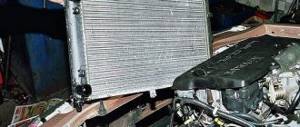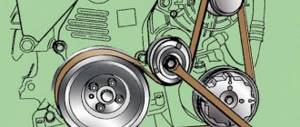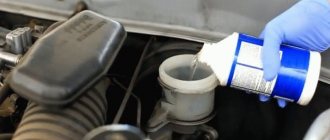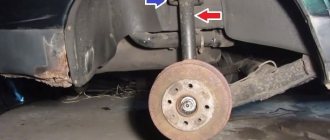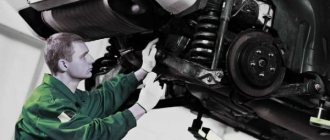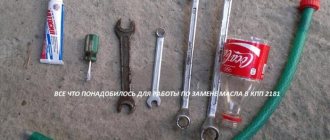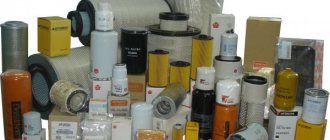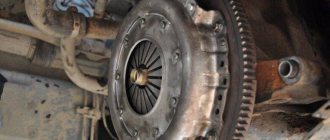07.08.2017
4500
Useful
Today there will be an extensive article dedicated to replacing consumables for your car. Those. we will talk about the regulations for replacing consumables such as oils (engine and transmission), all kinds of filters, spark plugs and other fluids that need to be changed at certain intervals.
You might think that there is nothing complicated about this, because almost all the information is in the instructions, but not everything is as simple as it might seem at first glance. All data indicated in the “Murzilka” related to the frequency of replacing a particular part (or liquid) is indicated for ideal operating conditions. Those. there must be ideal humidity, dust, temperature (about 25°), ideal road surface, ideal driving style (smooth acceleration, braking, do not raise the tachometer needle to the red zone), ideal fuel (which is practically impossible to achieve) and so on Further. This is not a complete list, but it includes all the main factors that we understand.
That is, as we see, it is very difficult to achieve ideal conditions, and in most cases, it is probably impossible. This is precisely why the replacement time for almost all consumables needs to be reduced. And to what extent should we reduce it? This will be discussed further.
And here is a small digression, I want to immediately say that all the figures that will be indicated below are quite approximate and were obtained by me based on my personal experience, the experience of my friends, the experience of the older generation and information taken from various automobile forums on the Internet.
How often should you change the oil?
And so, let's start with the most interesting thing - changing the engine oil . The instructions (each one is different) recommend changing the oil every 20 - 30,000 km. Agree, this is quite a long gap, and those who have at least once changed the oil themselves could clearly see this. During operation, the oil loses its original properties - its viscosity changes, oxidation processes occur, the so-called detergent-dispersant property deteriorates, due to which the oil, like a sponge, absorbs the products of fuel combustion, keeps them in suspension and does not allow them to settle on the surface details. And modern oils have quite a lot of such properties, and they all gradually deteriorate over time.
So, on average, engine oil remains operational for 10,000 km. Those. During this period of time, all the properties of the oil, all its additives do their job properly. And if you continue to drive beyond these 10 thousand (drive 12-15,000 km), then the properties of the oil will deteriorate to the point that they stop working altogether and begin to cause harm to the engine.
This is why I (and not only me) recommend changing the engine oil every 10,000 km. Or after 250-300 hours of engine operation. This is the approximate time it takes for an average car to achieve this mileage.
As for transmission oil ( box oil ), it is not in such harsh conditions as engine oil, and therefore can be changed much less frequently. Transmission oil, just like motor oil, contains a number of additives that improve its basic functions. And naturally, over time, these additives gradually begin to lose their properties. And since the oil is in a less aggressive environment, unlike motor oil (as I already said), its basic properties remain operational for a longer period of time.
Therefore, it is recommended to change the transmission oil once every 50,000 km. On cars with an automatic transmission, transmission oil ( automatic transmission oil ) is subject to heavy loads and therefore can be changed a little more often - once every 40,000 km.
There are a number of consumables that are best combined into one group and changed all at the same time. What kind of consumables are these? This is an air filter, a cabin filter, spark plugs, and if gas filters are installed, then gas filters.
So, according to the instructions, the air filter must be replaced every 20-30,000 km. The period for replacing spark plugs is approximately the same, maybe a little longer. And now I don’t mean any iridium or platinum spark plugs. I'm talking about the most ordinary candles that are installed by the manufacturer. It is recommended to change the cabin filter and LPG filters every 20-30,000 km. And I think you’ve already guessed where I’m going with this.
A couple of minutes ago I said that, according to the instructions, it is necessary to change the engine oil every 20-30,000 km, but we do this every 10,000. So, based on this, this group of consumables needs to be changed every 10 thousand km. Those. We drove 10 thousand, we change the engine oil and oil filter, of course, we also change the air filter, cabin filter, spark plugs and LPG filters.
When to change consumables on a car
Machine consumables are changed in two situations: during scheduled maintenance and when symptoms of a breakdown appear.
The frequency of maintenance is regulated by the car manufacturer. It indicates the period of its passage. Needless to say, the frequency of maintenance must be observed. But. There is a nuance. If you understand that the car experiences heavy loads every day, then the frequency of maintenance and subsequent replacement of consumables may increase.
What is meant by heavy loads:
- The car is used as a taxi.
- Every day he travels long distances on poor-quality roads.
- The car gets stuck in traffic jams every day.
- There is a place for frequent driving on cold oil.
- The car takes part in races.
- Inexpensive consumables and spare parts are used.
In such cases, it will not be superfluous to undergo preventive diagnostics once every 50,000 km.
The appearance of symptoms indicates a breakdown. Most often, replacing consumables is not enough, but often changing the oil and filters helps correct the situation.
How often to change antifreeze
It doesn’t matter whether you use antifreeze or antifreeze, in any case it needs to be changed. Modern engine cooling fluids also contain a number of certain additives that improve its basic properties. Namely, the freezing point and boiling point, heat transfer, increase resistance to foaming, and so on. And, naturally, over time, all these properties deteriorate. And therefore the coolant needs to be changed periodically.
Often, the manufacturer indicates the replacement time on the canister itself. On average, this is 3 years or about 60 thousand kilometers.
But also, in addition to this, it won’t hurt you to know a couple of points that will clearly help determine the condition of the coolant. The first thing you should pay attention to is color. The color of the liquid in the expansion tank should be almost the same as the color of the new liquid in the canister. If the fluid becomes cloudy or darker, then this is the first signal that it is time to think about replacing the fluid.
The second point is measuring the density of the liquid. Density directly indicates the concentration of ethylene glycol in the coolant and, as a result, its freezing point. The higher the density, the lower the freezing point. The density of modern liquids ranges from 1.034 to 1.112 g/cm³. You can see the density of your coolant on the canister. If, during measurement, the density of the old liquid differs from the new one, then it is better to replace it with a new one.
Engine oil + oil filter.
It is impossible to find out when it was changed and what was poured in, either by color, or by smell, or by anything else. I have repeatedly seen oil as clean as a tear in an engine that has worked for several thousand km. It’s just that the engine is clean and for some reason the oil has not darkened. And how many times have I seen almost black oil that was changed literally a thousand kilometers ago! The engine is the most expensive part of your car and saving some 1.5-2 thousand on it is the height of idiocy! Actually, if you don’t have money for engine oil, then you don’t need to buy a car!
The oil filter is changed with every oil change. The old one is thrown away. Doesn't wash.
It is better to change any type of oil more often. And, although routine maintenance indicates a mileage of 15 thousand km, this is the maximum value for guaranteed high-quality oil. Often the oil is of poor quality; its complex chemical chains disintegrate quite quickly under the influence of mechanical and thermal loads, and the oil loses its characteristics. Therefore, motorists change oil on average every 7–9 thousand km, and especially scrupulous ones - every 5–6 thousand.
Many people wonder whether it is necessary to flush the engine with a special “flush” liquid when changing the oil or not? This is a very complex question and there is no clear answer. Everyone must decide for themselves. The benefits of flushing are clear: old (not drained) oil is washed out, some of the dirt that has accumulated on the engine walls is washed away. But there is also a drawback: the risk that flushing will soften large layers of old dirt, which will fall off in lumps and these lumps will clog some of the thin oil lines and some engine components will begin to experience “oil starvation,” which will lead to a very rapid failure of the entire engine. Personally, I think that cars up to 5 years old can be washed safely, because there are practically no layers of dirt there. Old engines, 10 years and older, are really dangerous to flush. In addition, we must not forget that mineral oil produces much more buildup than synthetics. Synthetic oil practically does not create deposits; moreover, it has some cleaning properties. Therefore, if the previous owner poured “mineral water” into the engine, then it is better for you to follow this example, and do not flush it unnecessarily, and if he poured “synthetic water”, then feel free to pour synthetic water and you can flush the engine. You can put any oil into new engines - after all, you will sell the car before the problem appears. It is also not necessary to wash new engines, although if you wash them, nothing bad will happen.
How often to change brake fluid
The main problem with brake fluid is its hygroscopicity - i.e. ability to absorb moisture. The more the brake fluid absorbs moisture, the lower its boiling point, and for brake fluid this is not an unimportant indicator.
Therefore, it is recommended to change the brake fluid every two years or every 30-40,000 km. If you have driven such a distance, but are in doubt whether the fluid needs to be changed or whether it is still a little weak, then for such cases there are special devices that analyze the composition of the fluid and “say” whether replacement is needed or not.
And since we touched on the topic of brakes, a few more words about brake pads.
How often to change brake pads
As such, there is no clear limitation on the frequency of replacing brake pads. The pads can wear out within 30 - 40,000 km, or they can turn into dust within 5 thousand. There are many factors that influence wear. And what to do in such a situation? I will tell you how I personally determine whether the pads need to be changed or not. Twice a year I perform a mandatory procedure - switching from summer tires to winter tires and vice versa. At the same time, having removed the wheel, I inspect the brake mechanisms for any fluid leaks or any damage, and also clean them of accumulated dust. Well, of course I pay attention to the degree of wear of the brake pads. The thickness of the pad linings for disc brakes should not be less than 2-3 mm, and for drum type brakes - not less than 2-1.5 mm. If the thickness of the pads corresponds to these numbers, then you need to get ready and go to the auto store for new pads.
I think that now replacing consumables should not cause you any difficulties.
Engine 21126 “Priora” (1.6 l., 16 cl.)
A continuation of the evolution of VAZ 16-valve engines was the engine with index 21126. It is a development of 21124, but with some changes. Among them:
- Lightweight ShPG (connecting rod and piston group);
- Better surface treatment;
- Honing of cylinders with more stringent requirements.
The timing drive is a belt drive with overhead camshafts. But unlike its predecessor, when it breaks, the valve bends. There is a radical solution to this design feature - replacing the pistons. If the engine is of a standard design, then you just need to carefully monitor the condition of the belt. Moreover, the problem with its weakening was solved by installing an automatic tensioner. The type of belt used was also changed.
Typical faults
If you feel a loss of power, then most often the reasons for this are the following phenomena:
- Loss of compression due to a burnt-out cylinder head gasket;
- Wear of the cylinder wall;
- Wear of piston rings;
- Piston burnout.
The result of unstable operation and refusal to start may be a problem with pressure in the fuel system. In addition, such symptoms are caused by sensor malfunctions, air leaks through leaky hoses or their connections, timing problems, or problems with the throttle valve.
If the engine is clearly “troubling”, then, first of all, it is necessary to check the compression readings to eliminate the problem of valve burnout. But more often this is caused by faulty spark plugs or a malfunctioning ignition coil. Sometimes the reason lies in the condition of the injectors, namely in the degree of their contamination.
Floating speed is a completely typical disease of VAZ 16-valve engines. Often, in addition to this, the engine runs unevenly. In this case, first of all, it is necessary to check the mass air flow sensor (MAF). If it is working properly, then most likely the cause is the throttle valve. It is necessary to clean it, and possibly replace its position sensor (TPS). At the same time, you should check the condition of the idle air control (IAC).
This engine was not without its signature headache with the thermostat. It also becomes the reason that the engine cannot warm up to operating temperature. However, if there is severe frost outside, perhaps the old-fashioned method of using cardboard in front of the radiator will help.
Some characteristic problems of other VAZ engines migrated to the 21126 Priora. So, if you detect knocking noises under the hood, you should first check the condition of the hydraulic compensators. Most often, they are the culprits of unpleasant knocking noises. At the same time, knocking noises that are associated with main and connecting rod bearings, as well as pistons, familiar from other VAZ engines, can also occur. This is already a serious malfunction, which is fraught with difficult engine repairs.
Minor problems, such as refusal to start, most often lie in the following malfunctions:
- Starter and battery;
- Ignition coil;
- Candles;
- Fuel pump malfunction;
- Clogged fuel filter;
- Faulty fuel pressure regulator.
Having improved its technical characteristics, the 21126 motor is still slightly inferior to its predecessor 21124 in reliability. Although it cannot be said that it is inferior very significantly. This is mainly due to the more complex design. Nevertheless, it is one of the best domestic engines, which also fits into modern environmental standards.
The declared resource is 200 thousand km. Compared to the officially declared resources of its predecessors, it has increased. However, in practice, older motors with a simpler design generally last longer. If we judge by reviews of actual use, then on average the actual resource corresponds to that specified by the manufacturer. Sometimes it can be more, sometimes less. Much depends on operating conditions and level of service.
